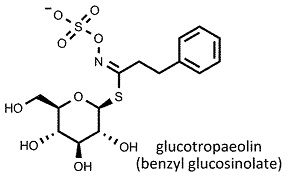 Lepidium sativum
Lepidium sativum
cress • garden cress • pepper grass
Back to “Salad herbs and herb mixtures: cress (Lepidium sativum)”
Back to “Culinary herbs: cress, garden cress (Lepidium sativum); garden cress, cress (Lepidium sativum)”
Lepidium sativum L. (Brassicaceae); kers, tuinkers (Afrikaans); jia du xing cai (Chinese); cresson alénois (French); Gartenkresse (German); alim (Indonesian); crescione (Italian); agrião, mastruco (Portuguese); berro de huerta, berro alenois, mastuerzo (Spanish)
DESCRIPTION Fresh leaves, young seedlings or sprouts are used. They have a peppery taste. Sprouts and seedlings are easily recognized by the deeply three-lobed cotyledons (seedling leaves).
THE PLANT An erect annual of up to 0.6 m (2 ft) high with compound leaves and minute white flowers.1 Seeds are borne in capsules of about 6 mm (¼ in.) long. Several similar and related plants are known as cress.2 Best known of all is watercress, Nasturtium officinale. Land cress or winter cress, Barbarea verna (Winterkresse in German, barbarée in French) has lobed leaves and yellow flowers. Nasturtium (Tropaeolum majus) is sometimes called Indian cress. Spoon cress or spoonwort, Cochlearia officinalis (Löffelkresse in German, cochléaire in French) was once an important source of vitamin C (to prevent scurvy) but has since declined in popularity after Citrus fruits became more readily available.2
ORIGIN Garden cress is thought to be indigenous to western Asia2 (but perhaps originally Ethiopia or Iran).1 It was used by the ancient Egyptians as a food source and became well known in parts of Europe (including Britain, France, Italy and Germany), where it is still a minor crop.
CULTIVATION Garden cress is propagated from seeds and grown as a spicy salad herb, often in kitchen gardens. It is a short-lived plant that matures in three to four months. Sprouts or seedlings are mostly used. Commercial growers germinate the seeds in special containers and sell these, container and all, as an early spring salad. Lepidium is the traditional component of so-called “mustard and cress”, a mixture of mustard and cress seedlings that are used as salad herb. The cress takes longer to germinate and is sown four days before the mustard.
HARVESTING For culinary use, cress leaves are harvested before flowering. Sprouts are gathered a few days after germination. Young plants should be carefully cleaned by removing the thicker stems and yellowing leaves, taking care not to soak them in water. For seed production, plants are left to mature, after which they are cut, dried and processed to collect the seeds.
CULINARY USES Cress is most commonly used in the form of sprouts or young seedlings, as a tasty and healthy garnish for salads and sandwiches. Young plants may be used as a garnish in grilled (broiled) dishes3 and are added to soups. They have a slightly peppery and somewhat bitter taste, and a slightly pungent odour. Cress purée was once a popular food item in France, where several types of cress are still used to some extent (watercress being the most popular).3
FLAVOUR COMPOUNDS Like other members of the mustard family, cress has sulphur-containing compounds (glucosinolates). The major compound in Lepidium leaves and seeds is glucotropaeolin, also known as benzyl glucosinolate.4

NOTES Cress seeds are an important commercial source of cooking oil in India; the seeds yield 25% of a yellowish-brown, semi-drying oil.1
1. Jansen, P.C.M. 2004. Lepidium sativum L. In: Grubben, G.J.H., Denton, O.A. (Eds), Plant resources of tropical Africa 2. Vegetables, pp. 365–367. PROTA Foundation, Wageningen.
2. Mabberley, D.J. 2008. Mabberley’s plant-book (3rd ed.). Cambridge University Press, Cambridge.
3. Larousse. 1999. The concise Larousse gastronomique. Hamlyn, London.
4. Williams, D.J., Critchley, C., Pun, S., Chaliha, M., O’Hara, T.J. 2009. Differing mechanisms of simply nitrile formation on glucosinolate degradation in Lepidium sativum and Nasturtium officinale seeds. Phytochemistry 70: 1401–1409.